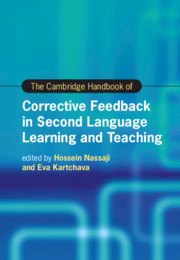Book contents
- The Cambridge Handbook of Corrective Feedback in Second Language Learning and Teaching
- Cambridge Handbooks in Language and Linguistics
- The Cambridge Handbook of Corrective Feedback in Second Language Learning and Teaching
- Copyright page
- Contents
- Figures
- Tables
- Contributors
- Acknowledgments
- Introduction Corrective Feedback in Second Language Teaching and Learning
- Part I Theoretical Perspectives on Corrective Feedback
- Part II Methodological Approaches in the Study of Corrective Feedback
- 5 Tools to Measure the Effectiveness of Feedback
- 6 Laboratory-Based Oral Corrective Feedback
- 7 Classroom-Based Research in Corrective Feedback
- 8 Meta-Analysis and Research Synthesis
- Part III Different Delivery Modes of Corrective Feedback
- Part IV Feedback Provider, Feedback Intensity, and Feedback Timing
- Part V Corrective Feedback and Language Skills
- Part VI Contexts of Corrective Feedback and Their Effects
- Part VII Learners’ and Teachers’ Feedback Perspectives, Perceptions, and Preferences
- Part VIII Individual Differences, Tasks, and Other Language- and Learner-Related Factors
- Index
- References
6 - Laboratory-Based Oral Corrective Feedback
from Part II - Methodological Approaches in the Study of Corrective Feedback
Published online by Cambridge University Press: 26 February 2021
- The Cambridge Handbook of Corrective Feedback in Second Language Learning and Teaching
- Cambridge Handbooks in Language and Linguistics
- The Cambridge Handbook of Corrective Feedback in Second Language Learning and Teaching
- Copyright page
- Contents
- Figures
- Tables
- Contributors
- Acknowledgments
- Introduction Corrective Feedback in Second Language Teaching and Learning
- Part I Theoretical Perspectives on Corrective Feedback
- Part II Methodological Approaches in the Study of Corrective Feedback
- 5 Tools to Measure the Effectiveness of Feedback
- 6 Laboratory-Based Oral Corrective Feedback
- 7 Classroom-Based Research in Corrective Feedback
- 8 Meta-Analysis and Research Synthesis
- Part III Different Delivery Modes of Corrective Feedback
- Part IV Feedback Provider, Feedback Intensity, and Feedback Timing
- Part V Corrective Feedback and Language Skills
- Part VI Contexts of Corrective Feedback and Their Effects
- Part VII Learners’ and Teachers’ Feedback Perspectives, Perceptions, and Preferences
- Part VIII Individual Differences, Tasks, and Other Language- and Learner-Related Factors
- Index
- References
Summary
This chapter explores various aspects of lab-based research and considers its merits and limitations. We begin with a discussion and definition of lab-based research, considering not only the research venue, the instructor, and the instructional tasks, distinguishing amongst three types of research contexts: lab, classroom with intervention, and classroom without intervention. This differentiation is important in understanding the continuous nature of corrective feedback studies, ranging from lab-based to classroom-based. We further differentiate studies based on the amount of manipulation that is involved, with lab study and classroom intervention studies being characterized by manipulation and nonintervention classroom studies characterized by not having manipulation. We discuss a variety of lab-based studies where there are different degrees of researcher control, illustrating a wide range of research types. Finally, in this chapter we present results from meta-analyses that compare lab-based corrective feedback studies with classroom studies showing greater evidence of the effectiveness of corrective feedback in lab-based studies. Future directions for research in corrective feedback in classroom- versus lab-based studies are outlined.
- Type
- Chapter
- Information
- The Cambridge Handbook of Corrective Feedback in Second Language Learning and Teaching , pp. 130 - 146Publisher: Cambridge University PressPrint publication year: 2021
References
- 2
- Cited by

